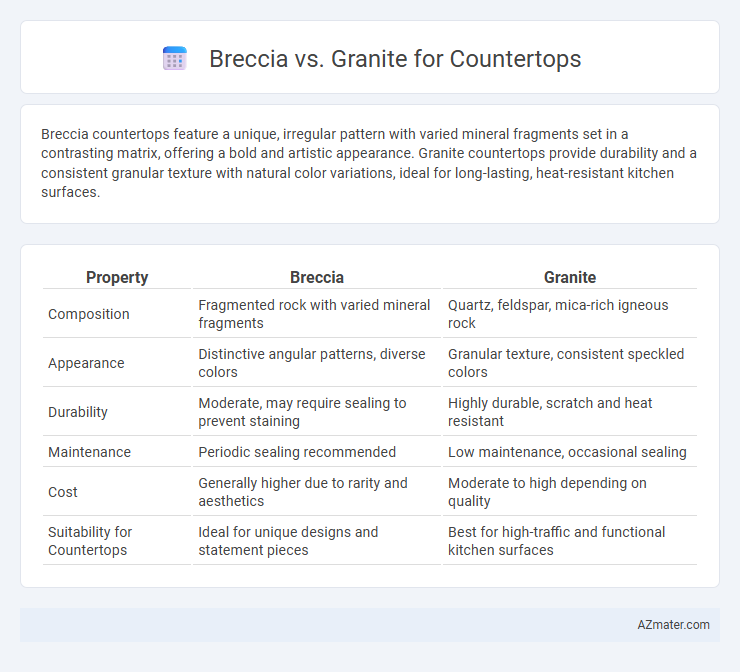Breccia countertops feature a unique, irregular pattern with varied mineral fragments set in a contrasting matrix, offering a bold and artistic appearance. Granite countertops provide durability and a consistent granular texture with natural color variations, ideal for long-lasting, heat-resistant kitchen surfaces.
Table of Comparison
| Property | Breccia | Granite |
|---|---|---|
| Composition | Fragmented rock with varied mineral fragments | Quartz, feldspar, mica-rich igneous rock |
| Appearance | Distinctive angular patterns, diverse colors | Granular texture, consistent speckled colors |
| Durability | Moderate, may require sealing to prevent staining | Highly durable, scratch and heat resistant |
| Maintenance | Periodic sealing recommended | Low maintenance, occasional sealing |
| Cost | Generally higher due to rarity and aesthetics | Moderate to high depending on quality |
| Suitability for Countertops | Ideal for unique designs and statement pieces | Best for high-traffic and functional kitchen surfaces |
Introduction to Breccia and Granite Countertops
Breccia countertops showcase a dramatic, fractured stone pattern composed of angular fragments bonded by a finer matrix, offering a unique, artistic appeal in natural stone surfaces. Granite countertops feature a dense, granular texture with consistent mineral grains, valued for exceptional durability, heat resistance, and low maintenance in kitchen environments. Both materials are prized for their natural beauty and strength but differ in visual complexity and textural uniformity, influencing design choices and installation considerations.
Geological Origins: Breccia vs Granite
Breccia countertops originate from fragmented rock pieces cemented together through natural geological processes, showcasing a unique angular texture formed by tectonic activity and sedimentation. Granite, a coarse-grained igneous rock, crystallizes deep within the Earth's crust from slow-cooling magma, resulting in a durable, interlocking mineral structure composed mainly of quartz, feldspar, and mica. The contrasting geological origins--sedimentary breccia versus plutonic igneous granite--impact their appearance, texture, and durability for countertop applications.
Appearance and Color Variations
Breccia countertops showcase a striking appearance characterized by fragmented patterns and varied shapes, creating a dynamic mosaic of colors ranging from earthy reds and browns to creams and grays. Granite offers a more uniform appearance with consistent grain patterns and natural flecks, displaying a broad palette that includes blacks, whites, greens, and blues. The bold, contrasting design of Breccia appeals to those seeking a statement surface, while granite's subtle variations provide timeless elegance and versatility.
Durability and Strength Comparison
Breccia countertops exhibit impressive durability due to their natural composite structure of angular fragments bonded by a fine-grained matrix, making them resistant to cracking and chipping under daily use. Granite, known for its dense crystalline composition, offers exceptional strength and hardness, providing superior resistance to scratches, heat, and heavy impact. While granite generally surpasses breccia in overall strength, breccia's unique pattern and adequate toughness make it a durable alternative for many countertop applications.
Cost Differences: Breccia vs Granite
Breccia countertops typically cost more than granite due to their unique veining patterns and rarity, with prices ranging from $75 to $200 per square foot compared to granite's average of $40 to $100 per square foot. Granite is more widely available and generally easier to quarry, resulting in lower material and fabrication costs. Installation expenses for both materials are similar, but the overall price difference is primarily driven by breccia's aesthetic exclusivity and limited supply in the natural stone market.
Maintenance and Cleaning Requirements
Breccia countertops demand regular sealing to prevent stains due to their porous nature, while granite surfaces require sealing less frequently but still need proper care to maintain their durability. Cleaning Breccia involves gentle, pH-neutral cleaners to avoid etching, whereas granite is more resistant to common household cleaning agents but still benefits from non-abrasive products. Both materials require prompt spill cleanup to preserve their appearance and longevity, with Breccia being more sensitive to acidic substances compared to granite.
Stain and Heat Resistance
Breccia countertops offer moderate stain resistance but require regular sealing to prevent discoloration from oils and acidic substances. Granite is highly heat-resistant and can withstand hot pots without damage, making it ideal for kitchen surfaces exposed to high temperatures. Both materials resist heat well, but granite typically provides superior stain resistance due to its denser composition and lower porosity.
Popular Design Styles and Applications
Breccia countertops, characterized by their bold, fragmented patterns and dramatic veining, suit modern and eclectic design styles where statement surfaces create focal points in kitchens and bathrooms. Granite countertops, with their granular texture and natural color variations, complement traditional and rustic aesthetics, providing durable and timeless surfaces for high-traffic areas. Both materials offer versatile applications, but Breccia is favored for artistic, high-impact installations, while Granite excels in classic, functional countertop uses.
Environmental Impact and Sustainability
Breccia countertops typically have a lower environmental impact due to their natural composition from fragmented stone pieces, which often involves less extraction and waste compared to large granite slabs. Granite quarrying is energy-intensive and can result in significant ecosystem disruption, making breccia a more sustainable choice for eco-conscious homeowners. Furthermore, breccia's unique patterns reduce the need for extensive processing and finishing, contributing to reduced carbon emissions throughout its production cycle.
Choosing the Best Stone for Your Countertop
Breccia countertops offer a unique, artistic appeal with their fragmented patterns and vibrant color variations, making them ideal for homeowners seeking a bold, natural statement piece. Granite, renowned for its exceptional durability, resistance to heat and scratches, and wide range of consistent patterns, provides a practical choice for high-traffic kitchen environments. When choosing the best stone for your countertop, prioritize granite for long-lasting strength and ease of maintenance, while selecting Breccia for striking visual impact and distinctiveness.

Infographic: Breccia vs Granite for Countertop
 azmater.com
azmater.com